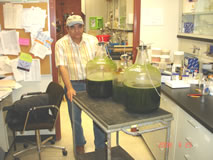Algae Color the Future Green – Renewable Energy Revolution – Money does not grow in water, trees and desert, but Renewable Energy does!
The Renewable Energy Revolution is on. Done correctly, it has the potential to create jobs, wealth, and prosperity and revitalize rural economies. Like it or not, biofuels, greenfuels and solar energy are no longer a dream on the far horizon—they are a commercial reality in the US and elsewhere. Political and economic leaders cannot continue ignoring it and bowing to petroleum kings, as well as, and farmers simply cannot afford to miss the opportunity that biofuels represent.
The Renewable Energy benefits both rich and poor countries—alleviating poverty in the developing world while helping to solve the problems of global energy security in developed nations. Government, universities, and the private sector need to focus efforts and support our farmers to enable them to participate in this worldwide movement that will shape our agricultural environment as never before.

In the case of Biofuels, in spite of the international quasi-war of “food versus fuels” slogan for biofuels opposition groups around the world, the reality USDA data demonstrated that that if US farmers just wanted to produce food they could do it on 25 million acres, and they have 500 million available. Additionally, there are enormous amounts of agricultural waste being dumped today, worsening the greenhouse effect, that could be transformed into fuel.
Nevertheless, it is also important that bioefuels revolution does not promote competition for land use in a way that puts food security at risk or leads to the destruction of rainforests or of other natural and semi-natural ecosystems.
Saying that, for more than half century, farmers in the United States have been subsidized to grow crops far beyond their domestic market needs. Then, with the aid of additional subsidies, the over-production has been exported around the world – or, unfortunately in many cases, simply stored up it goes bad and needs to be destroyed.
Many of us can clearly recall the images of mountains of butter, cheese, wheat and barley being composted and incorporated back into the soil so that the farmers were properly paid for producing them. Such a monumental waste of resources!
It is a huge irony therefore that with most of these surpluses now behind us, the first generation of biofuels production has caused such a change in this picture of comparative abundance. Suddenly there’s an international food crisis because of biofuels! And “food versus biofuels” has caught the attention of well-organized special interest groups, politicians and renowned international development agencies. Now these well-known opposition groups have been working to mobilize public opinion against the amazing revolution in front of us.
However, there are very solid facts that show the real benefits of biofuels and greenfuels. In the last forty years, Brazil has successfully demonstrated a remarkable biofuels revolution program based on the production of sugarcane-derived bioethanol. Brazil has established that agriculture can create products that have strategic value in the global economy. Currently, bioethanol has replaced almost 50 percent of gasoline in Brazil. This transfer has generated huge profits and social benefits by saving on petroleum imports and creating more jobs and sustainable income, especially in rural areas.
Consequently, many others developing countries, like India and China, are following Brazil’s example by setting ambitious goals for local production of biofuels. Both China and India are currently making big efforts to increase feedstock production based on maize and sugarcane, respectively.
As a matter of fact, China plans to increase its biofuel production fourfold in the next 15 years. This large Asian country aims to reach 15 billion liters of bioethanol by 2020. India has a similarly aggressive biofuels program. To reach their petroleum replacement goal, China would need increase maize production by 26 percent and India would need to produce 16 percent more sugar cane. These target numbers would create immense opportunities for rural areas if done correctly. We need to keep in mind that together, India and China could be responsible for close to 70 percent of the estimated worldwide increase in oil demand by 2025.
The Renewable Energy Revolution is happening all over the world. It must be extended to our farmers. As one who has been promoting Integrated Agriculture-Aquaculture-Biofuels for many years (long before it was a buzzword), waste reprocessing, Solar Energy and Rural Development programs in Arizona, Hawaii and in many parts of the World, I have joined the international efforts to provide the public with true facts about the amazing benefits of this revolution, as well as demonstrating that not all biofuels are the same. We need to be informed about what should be done to establish a sustainable and profitable Biofuels Industry that truly benefits our communities.
Algae Coloring The Future Green eBook Available at Amazon.com

The ebook Algae Color the Future Green of Drs. John Kyndt and Aecio D’Silva is intended for scientists, entrepreneurs, students, engineers, algae growers and investors that are interested in the potential algae have for fuel production, as well as, manufacture of high value chemicals, cosmetics and pharmaceuticals.
Although algae have been thought of as a potential fuel source in the past, it wasn’t until the skyrocketing fossil fuel prices in 2008 that this miniscule source of power was taken seriously.
Previously mainly known as “pond scum” and a plague for pool owners and fish farms, algae are now being seen as a promising and emerging investment for future energy sources. In the last two years there have been several announcements of million dollar investments from both private and government sources into the algae for fuel concept.
Think for example of the Exxon-Mobile announcement of a $600 million investment in algae biofuels, and the recent $45 million DOE funding of the National Alliance on Advanced Biofuels and Bioproducts (NAABB) to perform algae-derived fuel research.
With all these million dollar investments and with even the world’s largest airplane maker, Boeing, turning its eyes on algae, it is clear that the race to develop the next generation fuel from algae is on.
This publication provides the foundation for a strategy development, based on the industry strength and opportunities, while mitigating its risks and managing threats.
It provides an in-depth analysis of the current algae industry with advice on how to avoid common pitfalls when growing and harvesting algae yourself. It also highlights the emerging opportunities in this exciting field.
Both Drs. Kyndt and D’Silva are renowned scientists and entrepreneurs who have been actively promoting the potential of using algae for sustainable production of fuel, feed, chemicals and pharmaceuticals in their papers, books, conferences, workshops in many parts of this world.
The authors introduced algae for biofuel research to the Mike Cusanovich’ Lab at the University of Arizona. Mike was very supportive of the concept and as a consequence, his lab was one of the driving forces to create the National Alliance for Advanced Biofuels and Bioproducts (NAABB).
Member of American Aquabiotech, Biofuels Revolution, Algae for Biofuels and MyBeloJardim Group